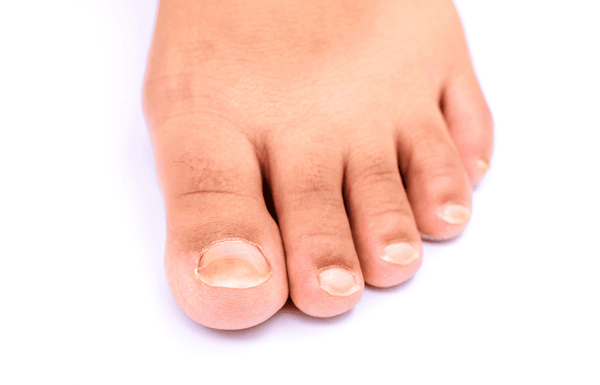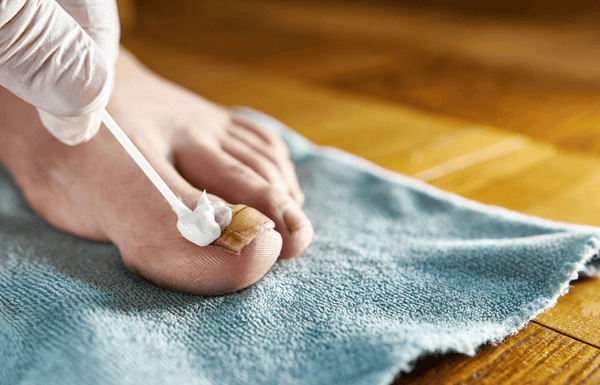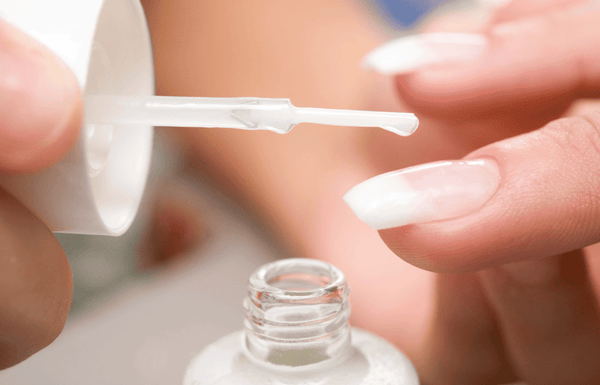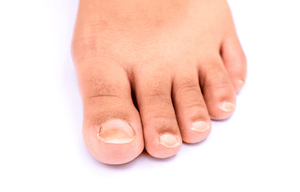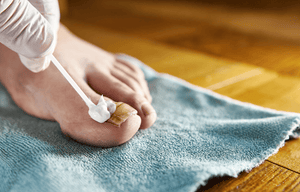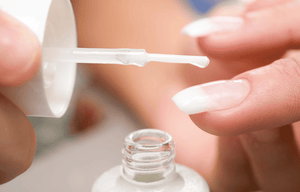
Our toenails are constantly exposed to friction, moisture, and impact, making them susceptible to a lot of uncomfortable and/or unsightly issues. One of the most common is nail discoloration, where there’s a change in hue, perhaps a thickening, or an odd texture.
Some changes are often harmless, like a temporary bruise, but others could be a tell-tale sign of something more persistent: toenail infection, often caused by a fungal invasion.
Recognizing the early signs of toenail fungus often leads to easier, more effective treatment. Ignoring it can allow the infection to worsen, potentially causing pain, discomfort, and a more challenging treatment journey.
Learn how to tell if you have nail fungus, including the various forms of nail discoloration and other accompanying toenail fungus symptoms.
Read on to learn more about foot infection by fungi, common household habits that help it spread, and fungus prevention tips that actually work to protect your feet and your family.
What Is Nail Fungus?
To understand what you're up against, let's start with the basics. Nail fungus, medically known as onychomycosis, is an infection of the nail bed, usually caused by tiny organisms called dermatophytes.
These microscopic fungi are opportunistic, thriving in environments that are warm, dark, and moist, conditions perfectly met inside your shoes and socks.
Once these fungi take hold, they begin to spread, often starting at the tip or side and gradually working their way deeper toward the nail plate and sometimes even the nail bed beneath.
The visual changes you observe are a direct result of this ongoing fungal activity, making discolored toenails one of the most prominent indicators of an underlying issue.
Common Types of Nail Discoloration and What They Might Mean
Yellow Nails
The most common and recognizable sign associated with nail fungus, yellow toenails can be uniform or appear in patches. This discoloration occurs as fungus proliferates within the nail plate, causing a buildup of keratin. If the yellowing is accompanied by other symptoms like thickening or brittleness, fungal nails are highly probable. However, yellow nails aren't exclusively a sign of fungus. Conditions like psoriasis can also cause yellowing, so can medications, or even the chemicals from prolonged use of dark nail polish without a base coat. Smoking is another lifestyle factor that can lead to a yellowish tint.
White Spots or Streaks
The appearance of white spots or streaks on the nail surface can be an early sign of toenail fungus. These might start as small, chalky white areas on the surface of the nail plate. In some cases, it can indicate a superficial fungal infection. Alternatively, white spots can simply be the result of minor trauma to the nail from bumping your toe. The difference is that trauma-induced spots typically grow out with the nail, whereas fungal white spots spread or persist.
Brown or Black Nails
Darker discolorations like brown or black point to a severe toenail infection, especially if molds are involved in the fungal growth. The fungus produces pigments that stain the nail a dark color. However, a brown or black nail can also be a sign of a subungual hematoma, a bruise under the nail caused by trauma. In rare but critical cases, a dark streak or spot under the nail could be melanoma, a serious form of skin cancer. This is why any persistent dark discoloration warrants professional medical attention.
Green Nails
If your nails appear green, it's generally not a fungal infection you're dealing with. Green nail syndrome (chloronychia) is typically caused by a bacterial infection, most commonly Pseudomonas aeruginosa. Since this requires a different treatment approach than a fungal infection, accurate diagnosis is extremely important.
Other Toenail Fungus Symptoms (Beyond Discoloration)
While nail discoloration is a primary indicator, toenail fungus symptoms extend beyond mere color changes. Pay attention to other physical signs like:
- Thickened or distorted nail shape
- Brittle, crumbling, or ragged edges
- Nail lifting or separating from the nail bed (Onycholysis)
- Mild odor
- Spread to other nails or the surrounding skin
When to Be Concerned
Given that some nail changes can be harmless, how do you know when to seek professional help? Be particularly concerned if you observe any of the following:
- Discoloration that spreads or worsens over time
- Pain, swelling, or signs of secondary infection
- Nail changes that don’t grow out with time
What to Do If You Suspect Nail Fungus
1. Start with OTC Antifungal Products for Mild Cases
For very mild, early-stage infections, over-the-counter antifungal creams, sprays, or lacquers might be effective. Follow the product instructions diligently, as consistency is key.
2. Practice Good Foot Hygiene
Keep your nails trimmed short and straight across. Ensure your feet are clean and, crucially, thoroughly dry, especially between the toes, after showering or bathing.
3. Avoid Nail Polish or Artificial Nails While Treating
While it’s tempting to cover up discolored toenails, nail polish and artificial nails can trap moisture and exacerbate the fungal infection. It's best to let your nails breathe and expose them to air as much as possible.
4. See a Podiatrist or Dermatologist
If your symptoms persist despite home treatment, if the infection appears severe, is painful, or seems to be worsening, it's time to consult a healthcare professional. A podiatrist or a dermatologist can accurately diagnose and recommend appropriate treatment.
Diagnosis and Professional Treatment Options
When you visit a specialist for nail fungus symptoms and treatment, they will likely take a small sample of the nail or debris from under it to send to a lab to confirm the presence of fungus and identify the specific type. For moderate to severe infections, oral medications like terbinafine or itraconazole are often prescribed. These are highly effective to reach the fungus through the bloodstream, but they require a prescription and monitoring for potential side effects, particularly involving the liver. Stronger prescription-strength topical solutions (e.g., ciclopirox, efinaconazole) can be applied directly to the nail. While less effective for deep-seated infections than oral medications, they are often used for milder cases or in combination therapy. Some medical lasers can also target and destroy fungus within the nail, often for cases resistant to other treatments or for patients who cannot take oral medications. In very severe, painful, or persistent cases where other treatments have failed, partial or complete removal of the infected nail may be considered to allow a healthy nail to grow back.
Tips for Prevention
- Don’t Go Barefoot in Public Places
- Rotate Shoes and Wear Moisture-Wicking Socks
- Disinfect Nail Tools and Avoid Sharing Them
- Treat Athlete’s Foot Early and Fungal Nails Early
Kick Nail Fungus to the Curb
Keep in mind that not all nail discoloration is a fungal nail infection, but it's undoubtedly one of the most common causes.
By recognizing the early signs of toenail fungus, such as yellowing, thickening, or brittleness, you can take proactive steps before the infection gets out of control.
Kick nail fungus to the curb! Try Dr. AntiFungus sprays and soaks formulated by doctors and made with prescription-grade ingredients that annihilate pesky fungal infections.